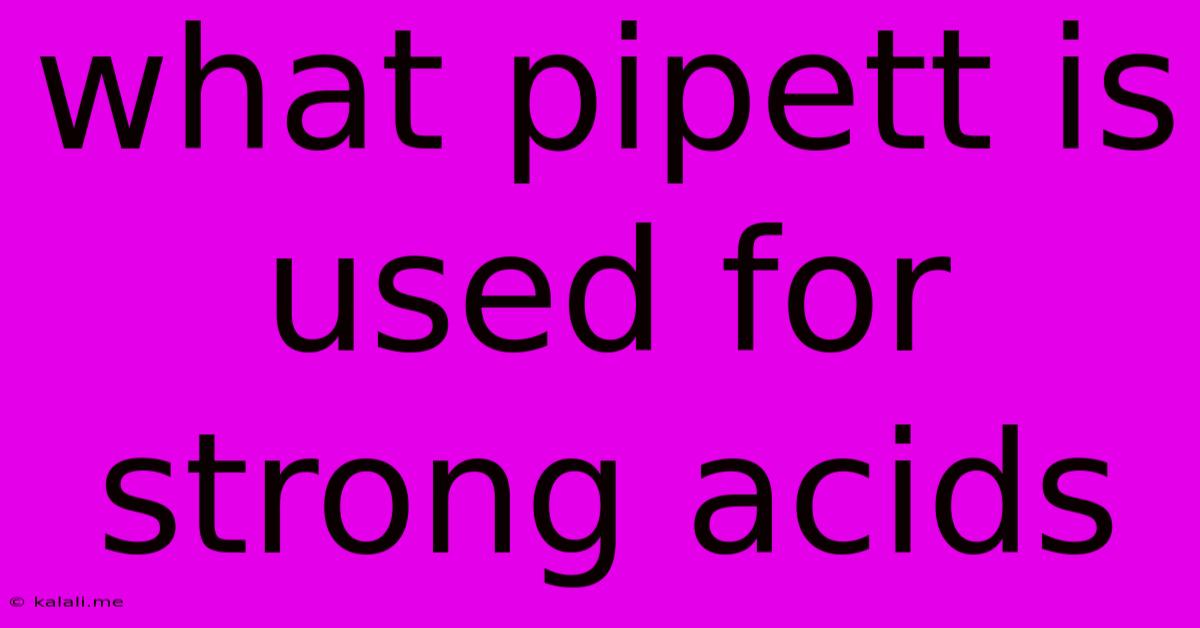What Pipett Is Used For Strong Acids
Kalali
May 25, 2025 · 3 min read

Table of Contents
What Pipette is Used for Strong Acids? Choosing the Right Pipette for Aggressive Chemicals
Strong acids present unique challenges when it comes to accurate and safe liquid handling. Their corrosive nature necessitates the use of specialized pipettes designed to withstand chemical degradation and prevent contamination. This article will explore the best pipette choices for handling strong acids, focusing on materials, features, and safety considerations. Choosing the wrong pipette can lead to equipment damage, inaccurate results, and potentially serious injury.
Understanding the Risks of Handling Strong Acids
Strong acids, such as sulfuric acid, hydrochloric acid, and nitric acid, are highly corrosive and can cause severe damage to both equipment and personnel. Exposure can lead to chemical burns, respiratory problems, and other health hazards. Therefore, selecting appropriate personal protective equipment (PPE) and specialized lab equipment is paramount.
Choosing the Right Pipette Material: Resistance is Key
The material of the pipette is the most crucial factor when dealing with strong acids. Common pipette materials and their suitability are as follows:
-
Borosilicate Glass: While generally resistant to many chemicals, borosilicate glass isn't ideal for prolonged exposure to strong acids, especially at high concentrations. Repeated exposure can lead to etching and weakening of the glass, compromising accuracy and increasing the risk of breakage.
-
PTFE (Polytetrafluoroethylene): PTFE, also known as Teflon, is an excellent choice for strong acid handling. It exhibits exceptional chemical inertness and resistance to corrosion, making it a superior material for pipettes designed for aggressive chemicals. PTFE pipettes are durable and can withstand repeated use with strong acids.
-
FEP (Fluorinated Ethylene Propylene): Similar to PTFE, FEP offers excellent chemical resistance and is suitable for many strong acids. It's often a more cost-effective alternative to PTFE, though PTFE generally offers slightly better chemical resistance.
-
PP (Polypropylene): Polypropylene is a more common plastic, but its resistance to strong acids is limited and highly dependent on the specific acid and concentration. It's generally not recommended for handling concentrated strong acids.
Beyond the Material: Essential Pipette Features for Acid Handling
Beyond the material, several additional features contribute to safe and effective strong acid handling:
-
Leak-proof Design: A robust, leak-proof design is crucial to prevent spills and exposure. Look for pipettes with tight seals and durable construction.
-
Easy Disassembly and Cleaning: Thorough cleaning is essential after handling strong acids. Pipettes with easily disassembled parts simplify cleaning and allow for more effective removal of residual acid.
-
Calibration and Accuracy: Accurate measurement is crucial in many applications. Ensure your pipette is appropriately calibrated and maintains accuracy even after repeated use and cleaning.
Types of Pipettes Suitable for Strong Acids:
Several types of pipettes can be used with strong acids, provided they are made from appropriate materials:
-
Volumetric Pipettes: These are designed for delivering a precise volume of liquid. PTFE or FEP volumetric pipettes are suitable for strong acids.
-
Graduated Pipettes: These allow for the delivery of variable volumes. Again, PTFE or FEP are preferred materials.
-
Pasteur Pipettes (Droppers): While often made from glass, disposable Pasteur pipettes made of plastic, particularly PTFE or FEP, can be utilized for small-scale transfers of strong acids.
-
Motorized Pipettes (Electronic Pipettes): These offer precise and repeatable dispensing and can minimize the risk of human error and direct contact with the acid. However, the material of the disposable tips must be compatible with the strong acids.
Safety Precautions When Using Pipettes with Strong Acids:
- Always wear appropriate PPE: This includes gloves, eye protection, and a lab coat.
- Work in a well-ventilated area: Strong acids can produce harmful fumes.
- Use a fume hood: This is highly recommended for handling strong acids, especially concentrated solutions.
- Follow proper handling procedures: Refer to relevant safety data sheets (SDS) for detailed instructions on handling specific acids.
- Proper disposal: Dispose of strong acids and contaminated materials according to your institution's protocols.
By carefully selecting the correct pipette material and following appropriate safety procedures, you can minimize risks and ensure accurate handling of strong acids in your laboratory work. Remember, safety should always be the top priority.
Latest Posts
Latest Posts
-
Does Antifreeze Have A Shelf Life
May 25, 2025
-
Gitlab Dont Fail If Nothing To Commit
May 25, 2025
-
Error Unable To Communicate With Master
May 25, 2025
-
How Hot Does A Microwave Get
May 25, 2025
-
How Long For Polyurethane To Dry
May 25, 2025
Related Post
Thank you for visiting our website which covers about What Pipett Is Used For Strong Acids . We hope the information provided has been useful to you. Feel free to contact us if you have any questions or need further assistance. See you next time and don't miss to bookmark.